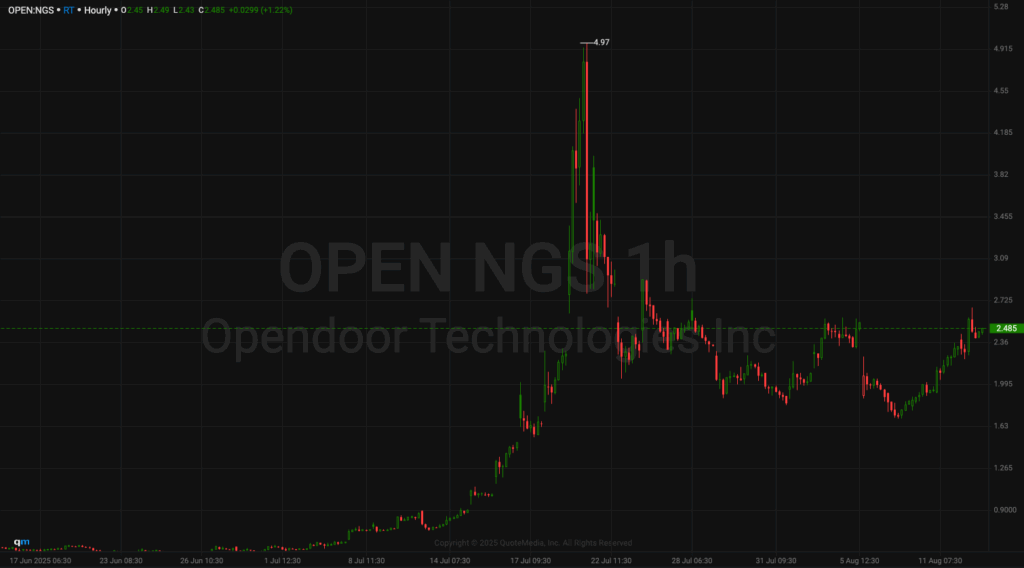Hey traders,
I want to test you today.
We’re looking at a chart frozen on July 21, 2025, right before I clicked the button on one of my biggest trades this year.
- Ticker: OPEN.
- Stock: Opendoor Technologies Inc. (NASDAQ: OPEN)
- Price: hovering near $4 per share.
- Volume: screaming higher than it had in weeks.

OPEN Hidden Chart
At this exact point, the stock had just tested the $4 area multiple times, with wicks showing rejection and sellers stepping in.
My plan: hit it short into that weakness, catch the fade, and bank a big win.
Now… here’s your mission:
Forget hindsight. Picture you’re me in that moment.
You’ve got size on.
You’ve been watching every tick for hours.
The market’s open and every candle feels like a punch in the ribs.
What happens next?
Option 1: The rejection sticks, it unravels fast, and I walk away smiling.
Option 2: It fakes lower, traps shorts, and rips back up.
Option 3: It chops sideways, burning commissions and patience.
Lock in your guess. Think it through like you’re about to risk six figures on this decision.
If you guessed Option 2, you nailed it.
The moment I leaned into that short, OPEN gave me just enough to feel confident.
A quick push lower, red on the tape, sellers leaning heavy at $3.98… all the right signals lining up.
Then came the little flickers, buyers absorbing prints without flinching, bids stacking just under $4, and that subtle shift where every downtick got met with a faster uptick.
It wasn’t violent at first. It was almost polite, like the stock didn’t want to scare me off before it took my money.
Opendoor Technologies Inc. (NASDAQ: OPEN) on July 21, 2025.

OPEN Chart July 21, 2025. Source: StocksToTrade
You’ve probably seen it: the kind of price action that feels cooperative until it doesn’t.
One second I’m green on the position. The next, $4 turns into a trampoline.
It pushed through with the kind of volume that makes you blink twice at your screen.
The sellers who were in control a minute ago? Gone.
Every short in the room started scrambling for the same tight exit.
That’s the thing about “obvious” levels. They attract everyone.
And when too many traders pile in, the first sign of trouble sparks a chain reaction.
All that short interest becomes fuel for the exact move you bet against.
Looking back, there were early warnings:
- Volume stayed stubbornly high even during the dips.
- The bids under $4 never fully thinned out.
- Rejections were shallow, no real follow-through.
I ignored them because I wanted the trade to work. I saw what I wanted to see. And in this game, that’s usually how you get trapped.
Learn from this, now we know, don’t confuse price stalling with price failing.
True breakdowns don’t hesitate, they accelerate.
If a level doesn’t crack clean on the first push, start questioning your read.
I walked away with a loss big enough to sting but small enough to keep trading the next day.

Source: Profit.ly
That’s the only reason I can write about it instead of replaying it in my head on repeat.
That’s the win inside the loss, you take the hit, protect the account, and keep yourself in the fight.
Trades like this don’t just test your chart reading. They test your discipline.
Passing that test means you’ll outlast the traders chasing only the easy wins.
See you on the next setup,
Jack Kellogg
P.S. If you want to see the kind of quiet pressure I just talked about before it breaks wide open, I’m going live tonight at 7 PM ET. This setup’s building right now, and it’s not Bitcoin, but what tends to move faster right behind it. Lock in your spot here.
